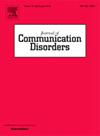Cognitive processing biases of social anxiety in adults who do and do not stutter
IF 2.1
3区 医学
Q2 AUDIOLOGY & SPEECH-LANGUAGE PATHOLOGY
引用次数: 0
Abstract
Purpose
Adults who stutter are at risk of developing high levels of social anxiety, leading to negative outcomes and contributing towards stuttering relapse post treatment. To ensure that psychological treatments for social anxiety in stuttering adults are relevant and effective, a broader empirical understanding of the mechanisms of social anxiety in stuttering populations is required. Four key cognitive processing biases identified as maintenance factors in cognitive behavioral models of social anxiety were examined: self-focused attention, safety behavior use, negative self-imagery, and interpretation bias.
Methods
Adults who stutter and non-stuttering adults (N = 186) were assessed via an online survey. Participants were categorised into two groups based on stuttering: formally diagnosed stuttering and non-stuttering. Within those groups, participants were further categorised as having low or high levels of social anxiety. Cognitive processing bias was assessed in response to two hypothetical social scenarios (i.e., social interaction and social performance).
Results
As predicted, in both adults who stutter and who are non-stuttering, high social anxiety was related to greater self-focused attention, safety behavior use and negative self-imagery compared to low social anxiety. No significant effect of social anxiety or stuttering was found in relation to interpretation bias. A significant effect of social anxiety upon negative self-imagery was observed in formally-diagnosed adults who stutter compared to non-stuttering adults.
Conclusion
The results support the use of cognitive behavioral models of social anxiety as a framework for research and treatment development within stuttering populations.
有口吃和没有口吃的成年人对社交焦虑的认知处理偏差。
目的:成人口吃者有可能产生高度社交焦虑,从而导致不良后果,并导致口吃治疗后复发。为确保针对成人口吃患者社交焦虑的心理治疗具有针对性和有效性,需要对口吃患者社交焦虑的机制有更广泛的实证理解。我们研究了社交焦虑认知行为模型中作为维持因素的四个关键认知加工偏差:自我关注、安全行为使用、消极自我想象和解释偏差:通过在线调查对口吃成人和不口吃成人(N = 186)进行了评估。根据口吃情况将参与者分为两组:经正式诊断的口吃者和非口吃者。在这些组别中,参与者又被分为社交焦虑程度低和高两类。针对两种假设的社交情景(即社交互动和社交表现),对认知加工偏差进行了评估:正如预测的那样,在口吃和不口吃的成年人中,与低社交焦虑相比,高社交焦虑与更多的自我关注、安全行为的使用和消极的自我想象有关。社交焦虑或口吃对解释偏差没有明显影响。与不口吃的成年人相比,被正式诊断为口吃的成年人的社交焦虑对消极自我想象有明显影响:研究结果支持将社交焦虑认知行为模型作为口吃人群研究和治疗发展的框架。
本文章由计算机程序翻译,如有差异,请以英文原文为准。
求助全文
约1分钟内获得全文
求助全文
来源期刊

Journal of Communication Disorders
AUDIOLOGY & SPEECH-LANGUAGE PATHOLOGY-REHABILITATION
CiteScore
3.30
自引率
5.90%
发文量
71
审稿时长
>12 weeks
期刊介绍:
The Journal of Communication Disorders publishes original articles on topics related to disorders of speech, language and hearing. Authors are encouraged to submit reports of experimental or descriptive investigations (research articles), review articles, tutorials or discussion papers, or letters to the editor ("short communications"). Please note that we do not accept case studies unless they conform to the principles of single-subject experimental design. Special issues are published periodically on timely and clinically relevant topics.
 求助内容:
求助内容: 应助结果提醒方式:
应助结果提醒方式:


